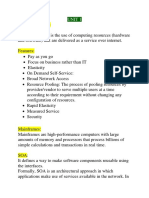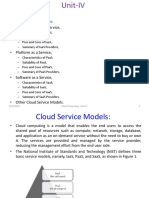0% found this document useful (0 votes)
33 views2 pagesCloud Computing Unit1 Clean Notes
Cloud computing offers on-demand computing services over the internet, characterized by features such as rapid elasticity and resource pooling. It encompasses various service models including IaaS, PaaS, and SaaS, and follows the NIST Cloud Computing Reference Architecture. The ecosystem includes major providers like AWS and Azure, and emphasizes automatic resource allocation and monitoring.
Uploaded by
nirmalchinta8923Copyright
© © All Rights Reserved
We take content rights seriously. If you suspect this is your content, claim it here.
Available Formats
Download as PDF, TXT or read online on Scribd
0% found this document useful (0 votes)
33 views2 pagesCloud Computing Unit1 Clean Notes
Cloud computing offers on-demand computing services over the internet, characterized by features such as rapid elasticity and resource pooling. It encompasses various service models including IaaS, PaaS, and SaaS, and follows the NIST Cloud Computing Reference Architecture. The ecosystem includes major providers like AWS and Azure, and emphasizes automatic resource allocation and monitoring.
Uploaded by
nirmalchinta8923Copyright
© © All Rights Reserved
We take content rights seriously. If you suspect this is your content, claim it here.
Available Formats
Download as PDF, TXT or read online on Scribd
/ 2
























































